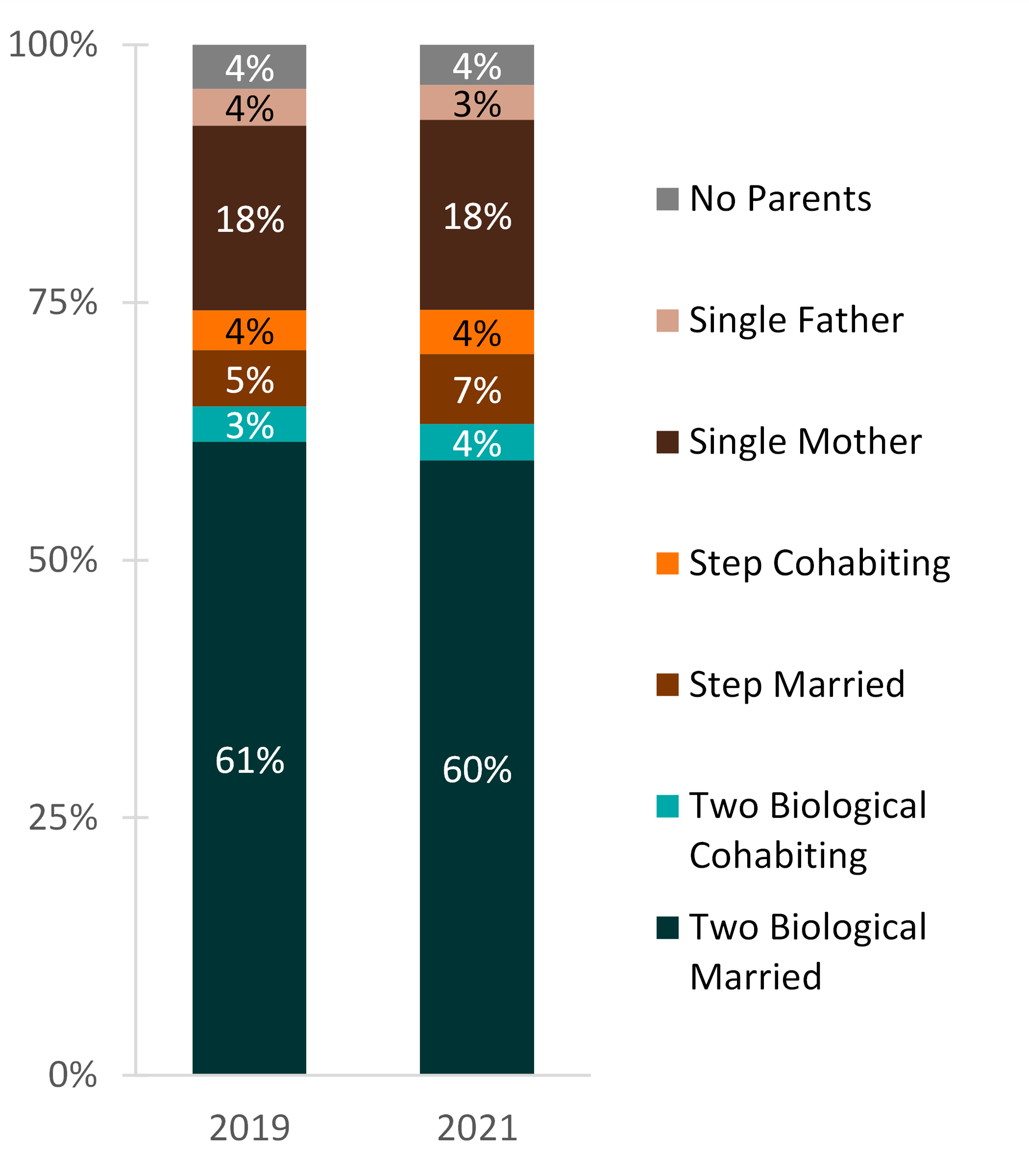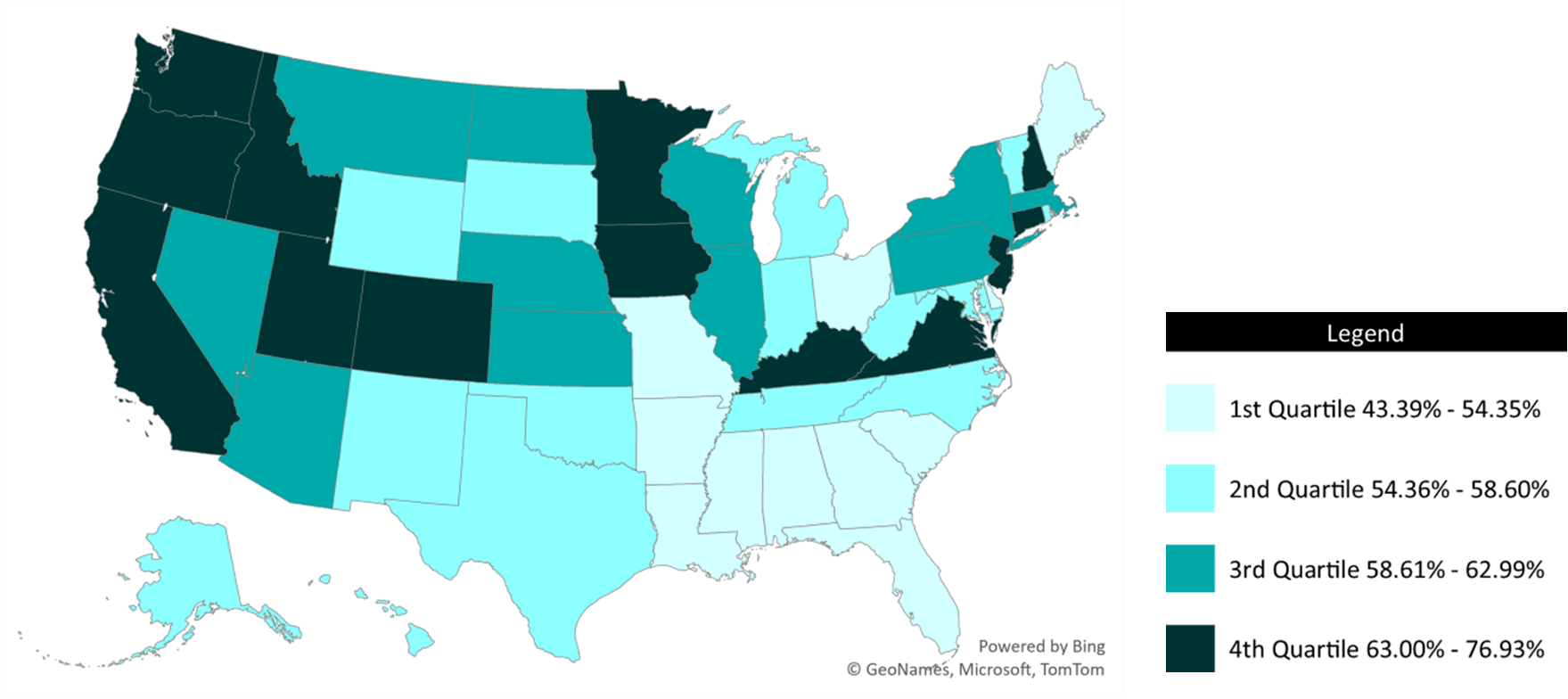Children’s Family Structure, 2021
Family Profile No. 26, 2021
Authors: Krista K. Westrick-Payne and Corrine E. Wiborg
Over the years, minor children’s family structure has experienced little change and has been well documented in previous family profiles (FP-17-15 & FP-13-19 & FP-19-25) and research. Consistent with prior work (Manning, Brown, & Stykes, 2014), U.S. children’s family structure has remained stable—with little to no change over the past ten years. Although changes to minor children’s family structure over time is small, examination of potential changes is still important. Using data from the 2021 ASEC Current Population Survey from IPUMS, this profile updates FP-19-25. We visualize variation in family structure of minor children (under the age of 18) in the U.S. by race/ethnicity. We also present state-level variation in the share of children living with two married biological parents.
- The majority of children were living with two biological parents (64%). This percentage is the same as observed in 2019 (FP-19-25).
- In 2021, among children living with two biological parents, the majority were living with married parents rather than cohabiting parents (94% vs. 6%). This is the same as 2019.
- The second most common family type was single parent families (21%). This percentage is nearly the same as 2019 (22%).
- A majority of these children were living with a single mother (86%) rather than a single father (14%). The share of children living with a single mother is the same as 2019.
- Children in stepfamilies has risen (11%). This is slightly higher than 2013 and 2019 (9%).
- Slightly more than half (64%) of children living in a stepfamily were living with married parents compared to 36% who were living with step-cohabiting parents.
Figure 1. Family Structure of Minor Children, 2019 & 2021

Notes: Due to small sample sizes, children from same-sex families are removed. The category of two “biological” also includes children living with two adoptive parent
Children’s Family Structure by Race/Ethnicity, 2019
- Two biological parent families were most common among Asian children (85%) followed by White children (70%). Black children had the smallest sharing living with two biological parents (35%).
- Cohabiting parent families were most common among Hispanic (12%) and 2+ Race children (11%). This percentage increased for both groups since 2019 (10%).
- Single mother families were more prevalent among Black children (42%) decreasing slightly since 2019 (44%). Similar shares of 2+ Race and Hispanic children were living in single mother families,22% and 21%, respectively.
Figure 2. Family Structure of Minor Children by Race/ Ethnicity, 2021

Geographic Variation in the Percentage of Children Living with Two Married Biological Parents
- Large variation exists in the share of children living with two married biological parents across states, ranging from a low of 43% in Mississippi to a high of 77% in Utah. 21 states have at least 60% of children with two married biological parents.
- Similar to 2019, children living with two married biological parents were largely located in the Western region of the U.S. (Utah, Idaho, Oregon, Washington, and California).
- Utah, Idaho, Oregon, and Washington were all in the top five in 2019. Utah took the number one spot in 2013, 2019, and 2021.
- In 2021, many states with the smallest share of children living with two married biological parents (bottom 25%) were located in the Southern Region of the U.S. Missouri, Georgia, Florida, South Carolina, Arkansas, Alabama, Louisiana, Mississippi).
- In both 2019 and 2021, Mississippi had the smallest share of children living with two married biological parents (43%) followed by Delaware (48%).
Figure 3. Geographic Variation in the Percentage of Children living with Two Biological Married Parents, 2021

Data Sources:
Flood, S., King, M., Rodgers, R., Ruggles, S., Warren, J. R., & Westberry, M. (2021). Integrated Public Use Microdata Series: Current Population Survey: Version 9.0 [dataset]. Minneapolis, MN: IPUMS. https://doi.org/10.18128/D030.V9.0
References:
Eickmeyer, K. J. (2017). American children’s family structure: Two biological parent families. Family Profiles, FP-17-15. Bowling Green, OH: National Center for Family & Marriage Research. https://www.bgsu.edu/ncfmr/resources/data/family-profiles/eickmeyer-two-biological-parent-families-fp-17-15.html
Manning, W. D., Brown, S. L., & Stykes, J. B. (2014). Family complexity among children in the United States. The ANNALS of the American Academy of Political and Social Science, 654(1), 48-65. https://doi.org/10.1177%2F0002716214524515
Payne, K. K. (2013). Children’s family structure, 2013. Family Profiles, FP-13-19. Bowling Green, OH: National Center for Family & Marriage Research. https://www.bgsu.edu/content/dam/BGSU/college-of-arts-and-sciences/NCFMR/documents/FP/FP-13-19.pdf.
Payne K. K. (2019). Children’s family structure, 2019. Family Profiles, FP-19-25. Bowling Green, OH: National Center for Family & Marriage Research. https://doi.org/10.25035/ncfmr/fp-19-25.
Suggested Citation:
Westrick-Payne K. K. & Wiborg, C. E. (2021). Children’s family structure, 2021. Family Profiles, FP-21-26. Bowling Green, OH: National Center for Family & Marriage Research. https://doi.org/10.25035/ncfmr/fp-21-26.
Updated: 11/12/2025 09:25AM


